
Goodyear F2G Racers at Falcon Field
|
Two Goodyear F2G Corsairs that competed in the 1949 Thompson Trophy Race were reunited for the first time in sixty-two years at the Commemorative Air Force ramp at Falcon Field, Mesa, Arizona on December 27, 2011. F2G-1 N5588N Race 57 and F2G-2 N5577N Race 74 were brought together for an air-to-air photo shoot over the Superstition Mountains. Race 57 has just undergone ten and a half months of restoration.
See the location where I photographed the F2G racers in Google Earth.
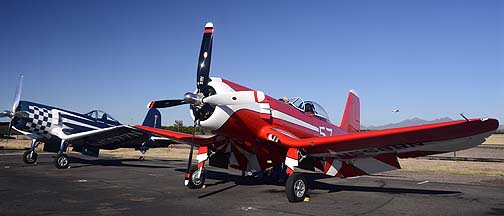 Race 74 is visiting the Arizona Wing of the Commemorative Air Force over the winter. Race 57 is based at Stellar Airpark in Chandler, Arizona. Now freshly restored, it was flown to Falcon Field on Monday December 26 to join Race 74.
Race 74 is visiting the Arizona Wing of the Commemorative Air Force over the winter. Race 57 is based at Stellar Airpark in Chandler, Arizona. Now freshly restored, it was flown to Falcon Field on Monday December 26 to join Race 74.
During World War II, engineers sought to increase the performance of the Vought F4U Corsair by installing a 4,360-cubic-inch, 28-cylinder engine in place of the standard 2,800-cubic-inch, 18-cylinder engine. The Pratt & Whitney R-4360 radial engine generated nearly twice the horsepower of the Pratt & Whitney R-2800 that equipped the standard Corsair. The R-4360 is the most powerful reciprocating engine ever installed in a single engine airplane.
Pratt & Whitney tested the compatability of the R4360 on F4U-1 Corsair, BuNo 02460. Goodyear modified two FG-1s, BuNo 13471 and BuNo 13472, to test the R4360 installation. Those Corsairs retained the FG-1 cockpit and turtle deck. Goodyear modified two FG-1s , BuNo 14091 and BuNo 14092, to evaluate the installation of a Republic P-47 teardrop canopy.
The production program for the R4360 equipped Corsair was assigned to the Goodyear Aircraft Company of Akron Ohio which manufactured the F4U under license as the FG. The new Corsair variant received the designation F2G. When the F2G went into production, it was referred to as Corsair, not Super Corsair.
The production F2G has a tear-drop canopy in place of the original Corsair cockpit and turtle deck. The vertical stabilizer of the F2G is 12 inches taller than on the standard Corsair and has an auxiliary rudder to counteract engine torque.
The rate of climb of the F2G was 7,000 feet per minute, twice the rate of climb of the standard Corsair and higher than the jet fighters of the time.
Only fifteen F2Gs were built: five pre-production XF2Gs (BuNos 14691 - 14695), five F2G-1s (BuNos 88454 - 88458), and five F2G-2s (BuNos 88459 - 88463). F2G-1s were intended to operate from land bases, not aircraft carriers. They had a manually operated wing fold mechanism and no tail hook. They were equipped with a fourteen-foot diameter propeller. F2G-2s were built with hydraulically powered wing fold mechanisms and tail hooks for carrier operations. Their propellers were thirteen feet in diameter.
Five F2Gs were converted to racing planes after the war: two pre-production XF2Gs (BuNos 14693 and 14694), two F2G-1s (BuNos 88457 and 88458), and one F2G-2 (88463).
Three F2Gs still survive; one F2G-1 in stock military configuration (BuNo 88454) and two of the racing F2Gs (BuNos 88458 and 88463).
 F2G-1 BuNo 88458 was the fifth F2G-1. It carries Goodyear construction number 6167. It was tested at Port Columbus, Ohio and Naval Air Station Patuxent River from October 1945 to July 1946. The Navy retired it in January 1948. Cook Cleland bought it for spare parts, but then registered it as NX5588N. That was the same registration worn by Cleland's F2G-1 BuNo 88457, which crashed at the 1947 Thompson Trophy Race. NX5588N raced as Race #57 in the 1949 Thompson and Tinnerman Trophy Races at Cleveland, Ohio.
F2G-1 BuNo 88458 was the fifth F2G-1. It carries Goodyear construction number 6167. It was tested at Port Columbus, Ohio and Naval Air Station Patuxent River from October 1945 to July 1946. The Navy retired it in January 1948. Cook Cleland bought it for spare parts, but then registered it as NX5588N. That was the same registration worn by Cleland's F2G-1 BuNo 88457, which crashed at the 1947 Thompson Trophy Race. NX5588N raced as Race #57 in the 1949 Thompson and Tinnerman Trophy Races at Cleveland, Ohio.
Ben McKillen Jr. piloted Race #57 to third place in the 1949 Thompson Trophy Race at a speed of 387.589 miles per hour, behind Cook Cleland in F2G-1 N5590N Race #94 (397.071 miles per hour) and Ron Puckett in F2G-1 N91092 Race #18 (393.527 miles per hour). McKillen won the 1949 Tinnerman Trophy Race in Race #57 at a speed of 386.069 miles per hour.
From 1950 to 1996, NX5588N passed through the hands of several owners, deteriorating progressively over years of outdoor storage. Robert J. Odegaard of Kindred, North Dakota acquired it on March 2, 1996. He performed a meticulous restoration of its appearance at the 1949 air races and returned it to airworthy condition in 1999.
Ron Pratte purchased Race 57 from the Odegaard Family in December, 2008, and has it based at Stellar Airpark in Chandler, Arizona. Larry Perkins is the chief pilot of Race 57 and the other aircraft in the Collectible Aircraft LLC collection.
Race 57 has undergone extensive restoration over a period of ten and a helf months. Bob Odegaard disassembled the airplane and removed the carburetor. Martin King overhauled the carburetor. Mechanic Julie White applied new fabric to the control surfaces. Don and Chris Copeland stripped and painted the components of the racer. Bob Odegaard rebuilt the landing gear, rebuilt the airframe, installed new hoses and reinstalled the carburetor.
The Race 57 program letter for calendar year 2012 includes the following events:
1) Cactus Fly-In, Casa Grande;
2) MCAS Yuma Airshow;
3) NAF El Centro Airshow;
4) Watsonville Airshow;
5) EAA Air Venture;
6) Reno Air Races; and
7) Copperstate Fly-In, Casa Grande
Bob Odegaard recently restored another of Cook Cleland's former racing mounts, F2G-1 BuNo 88463 N5577N Race #74 to airworthy condition for Tom Ungurean of Ohio.
Cook Cleland won the 1947 Thompson Trophy in it at 396.131 miles per hour. In 1949 Dick Becker qualified it for the Thompson Trophy Race at 414 miles per hour, but stripped the propeller reduction gear and did not race. In 1950 it was acquired by Walter Soplata and stored with his aircraft collection in Newberry, Ohio.
Bob Odegaard began its restoration for static display at the Crawford Auto Aviation Museum in Cleveland, Ohio in 2000, but funding dried up and it was purchased by Tom Ungurean. It has been restored in the blue and white colors that it wore at the 1949 Thompson Trophy Race. It was displayed at the EAA show in Oshkosh in July and at the Reno Air Races in September. Following its appearance at the Reno Air Races, Race 74 flew to Falcon Field in Tempe, Arizona and parked on the Commemorative Air Force ramp.
 There are some diffferences between the cowlings and inlets on the modified racers. Race 57 is equipped with a fourteen-foot diameter propeller. The white propeller blade was acquired from another F2G when Race 57 damaged a blade landing on a short airstrip.
There are some diffferences between the cowlings and inlets on the modified racers. Race 57 is equipped with a fourteen-foot diameter propeller. The white propeller blade was acquired from another F2G when Race 57 damaged a blade landing on a short airstrip.
 Race 74 is equipped with a thirteen-foot diameter propeller.
Race 74 is equipped with a thirteen-foot diameter propeller.
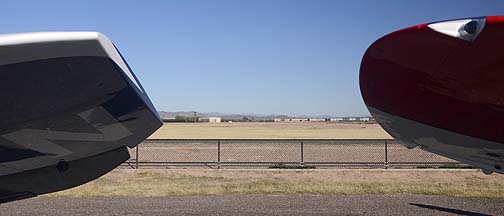 The wing tips of Race 74 have been clipped, but the wing tips of Race 57 are intact.
The wing tips of Race 74 have been clipped, but the wing tips of Race 57 are intact.
 Race 74 is equipped with a standard Corsair vertical stabilizer.
Race 74 is equipped with a standard Corsair vertical stabilizer.
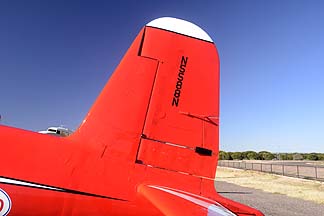 Race 57 is equipped with the taller vertical stabilizer and rudder developed for the F2G.
Race 57 is equipped with the taller vertical stabilizer and rudder developed for the F2G.
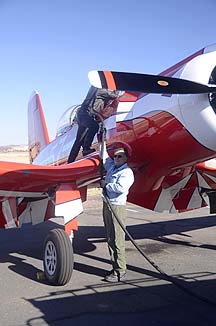 Bob Odegaard helping to fuel up Race 57.
Bob Odegaard helping to fuel up Race 57.
Thompson Trophy Racer Reunion, Falcon Field, Arizona, December 27, 2011: You can buy this photo as prints as large as 16" x 24".
 Bob Odegaard and the photographers pushed the Corsairs into a nose to nose position for more photography.
Bob Odegaard and the photographers pushed the Corsairs into a nose to nose position for more photography.
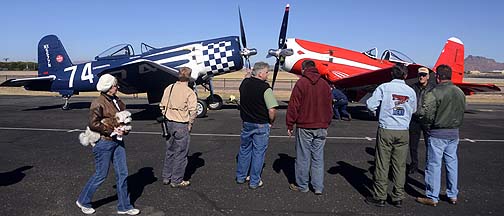 The team admires their handiwork.
The team admires their handiwork.
Thompson Trophy Racer Reunion, Falcon Field, Arizona, December 27, 2011: You can buy this photo as prints as large as 16" x 24".
Thompson Trophy Racer Reunion, Falcon Field, Arizona, December 27, 2011: You can buy this photo as prints as large as 12" x 36".
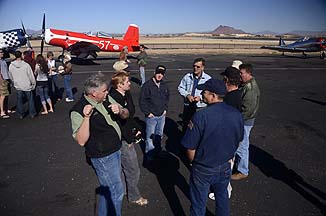 Bob Odegaard, the pilots and photographers discuss the upcoming air-to-air photo shoot.
Bob Odegaard, the pilots and photographers discuss the upcoming air-to-air photo shoot.
 The Odegaard family posed in front of the racing planes
The Odegaard family posed in front of the racing planes
 North American P-51D Mustang Cripes a Mighty N151BW was taken up for a flight.
North American P-51D Mustang Cripes a Mighty N151BW was taken up for a flight.
 North American P-51D Mustang Cripes a Mighty N151BW
North American P-51D Mustang Cripes a Mighty N151BW
 Stearman B75N1 N47964 made several revenue flights during the day.
Stearman B75N1 N47964 made several revenue flights during the day.
 North American P-51D Mustang Cripes a Mighty N151BW
North American P-51D Mustang Cripes a Mighty N151BW
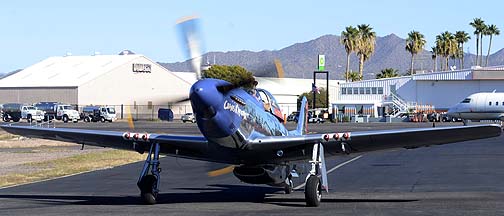 North American P-51D Mustang Cripes a Mighty N151BW
North American P-51D Mustang Cripes a Mighty N151BW
 North American P-51D Mustang Cripes a Mighty N151BW
North American P-51D Mustang Cripes a Mighty N151BW
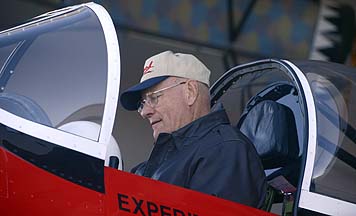 Larry Perkins is the pilot of Race 57.
Larry Perkins is the pilot of Race 57.
 Stearman B75N1 N47964 was built in 1943. Its construction number is 75-7540. It is powered by a Lycoming R-680-4P-B4 nine-cylinder radial engine. It is restored as US Navy N2S-3 964.
Stearman B75N1 N47964 was built in 1943. Its construction number is 75-7540. It is powered by a Lycoming R-680-4P-B4 nine-cylinder radial engine. It is restored as US Navy N2S-3 964.
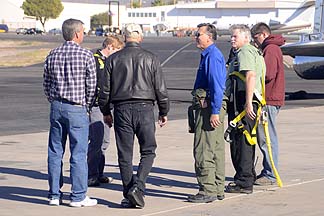 Larry Perkins joins Bob Odegaard and the photographers as they plan for th eair-to-air photo shoot. The photo shot would stage at the Coolidge Airport. The Corsairs would be joined by North American P-51D Mustang Cripes a Mighty N151BW. North American T-6G Texan N3158G and a Beech Bonanza A36 would serve as camera platforms. A Mooney transported extra personell to the Coolodge Airport.
Larry Perkins joins Bob Odegaard and the photographers as they plan for th eair-to-air photo shoot. The photo shot would stage at the Coolidge Airport. The Corsairs would be joined by North American P-51D Mustang Cripes a Mighty N151BW. North American T-6G Texan N3158G and a Beech Bonanza A36 would serve as camera platforms. A Mooney transported extra personell to the Coolodge Airport.
 Race 57 was towed away from the CAF ramp before starting up.
Race 57 was towed away from the CAF ramp before starting up.
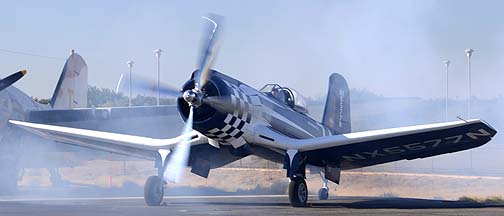 Race 74 belched a lot of smoke as it started its R-4360.
Race 74 belched a lot of smoke as it started its R-4360.
 Commemorative Air Force North American T-6G Texan N3158G was assigned Air Force serial 49-3152 after it was remanufactured. Its construction number is 168-256. A. D. Wells of Hayward, California registered it as N3158G in 1963. Dennis W. Childers of Broken Arrow, Oklahoma acquired it in 1986 and sold it to Dale Churchill of Mesa, Arizona on June 18, 1998. It flew as as USAF 93856/TA-856. It currently flies as Army Air Corps 23999/BP-255.
Commemorative Air Force North American T-6G Texan N3158G was assigned Air Force serial 49-3152 after it was remanufactured. Its construction number is 168-256. A. D. Wells of Hayward, California registered it as N3158G in 1963. Dennis W. Childers of Broken Arrow, Oklahoma acquired it in 1986 and sold it to Dale Churchill of Mesa, Arizona on June 18, 1998. It flew as as USAF 93856/TA-856. It currently flies as Army Air Corps 23999/BP-255.
Goodyear F2G-2 Corsair NX5577N Race 74 Falcon Field Arizona December 27 2011: You can buy this photo as prints as large as 16" x 24".
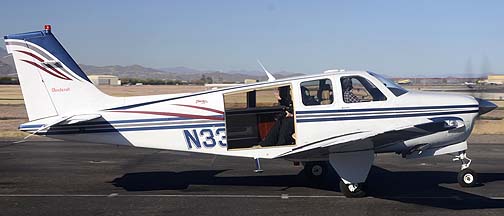 Beech Bonanza A36 with its door removed to provide the photographers with a clear view of the Corsairs.
Beech Bonanza A36 with its door removed to provide the photographers with a clear view of the Corsairs.
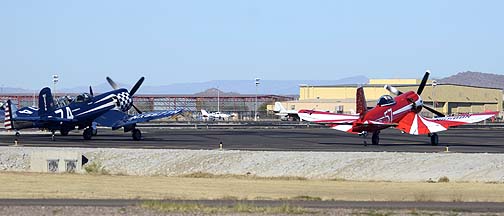 The Corsairs ran up their R-4360 engines as they prepared to depart.
The Corsairs ran up their R-4360 engines as they prepared to depart.
 Something was not right with the engine of Race 74, so the photography flight paraded back to the CAF ramp.
Something was not right with the engine of Race 74, so the photography flight paraded back to the CAF ramp.
Goodyear F2G-1 Corsair N5588N Race 57 Falcon Field Arizona December 27 2011: You can buy this photo as prints as large as 16" x 24".
 Race 74 taxied to the hangar. The team quickly removed the engine access panels and started working on the engine.
Race 74 taxied to the hangar. The team quickly removed the engine access panels and started working on the engine.
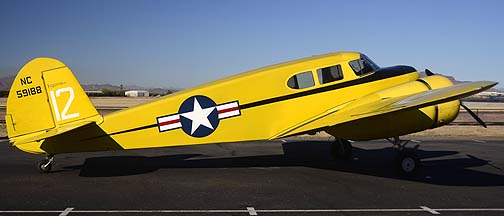 Cessna T-50 Bobcat N59188 was built in 1942. Its construction number is 3084.
Cessna T-50 Bobcat N59188 was built in 1942. Its construction number is 3084.
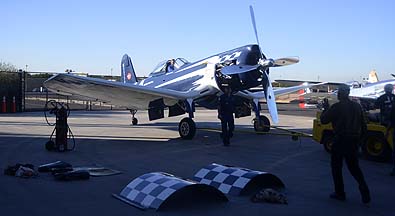 A half hour after the Corsairs taxied back in, Race 74 was positioned for an egnine test.
A half hour after the Corsairs taxied back in, Race 74 was positioned for an egnine test.
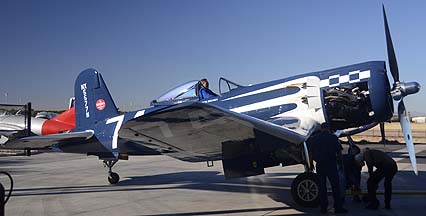 Bob Odegaard prepared for an engine test.
Bob Odegaard prepared for an engine test.
 The R-4360 radial engine belched smoke as Bob Odegaard started it up.
The R-4360 radial engine belched smoke as Bob Odegaard started it up.
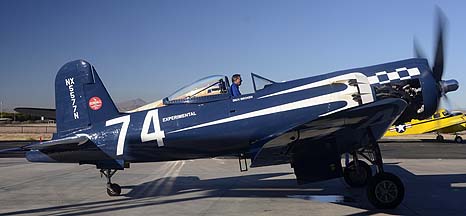 Bob Odegaard ran up the engine and declared that the airplane was ready to go. The engine was quickly buttoned up.
Bob Odegaard ran up the engine and declared that the airplane was ready to go. The engine was quickly buttoned up.
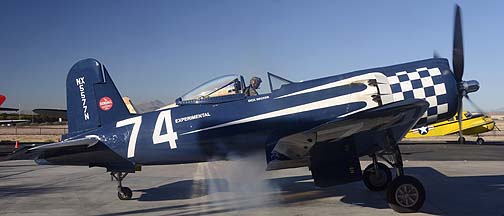 Another puff of smoke as Race 74 is started again.
Another puff of smoke as Race 74 is started again.
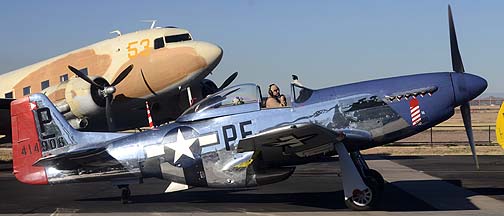 North American P-51D Mustang Cripes a Mighty N151BW followed the F2Gs to the runway.
North American P-51D Mustang Cripes a Mighty N151BW followed the F2Gs to the runway.
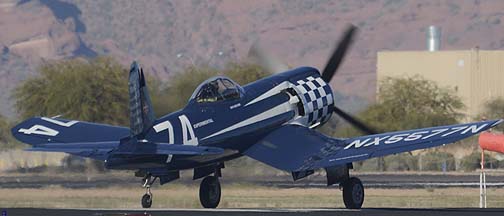 Race 74 took off and headed toward the Superstition Mountains.
Race 74 took off and headed toward the Superstition Mountains.
 Race 57 followed Race 74 down the runway to the photo shoot.
Race 57 followed Race 74 down the runway to the photo shoot.
You can buy a 2020 calendar featuring my photographs of Corsairs with Four Bank Radials.
A dozen photos of four Corsairs equipped with Pratt & Whitney R-4360 Wasp Major twenty-eight-cylinder, four-bank radial engines, three Goodyear F2Gs and the Super Corsair racing plane. F2G-1 N4324 remains in stock configuration. F2G-1 N5588N and F2G-2 NX5577N were converted for racing in the post-war Thompson Trophy Races. The Super Corsair racing plane N51318 was converted from a standard F4U in the 1980s. This calendar has been updated with photos from the first reunion of two of Cook Cleland's racing F2Gs in sixty-two years at the Arizona Wing of the Commemorative Air Force on December 27, 2011.
 Put a copy of the Corsairs with Four Bank Radials: 2020 Calendar in your Lulu.com shopping cart for $14.95.
Put a copy of the Corsairs with Four Bank Radials: 2020 Calendar in your Lulu.com shopping cart for $14.95.
- advertisement -
Send a message to Brian.